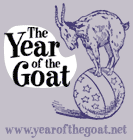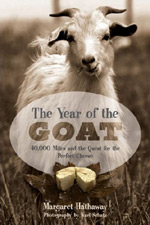The act, which was still in the early phases of rehearsal when we visited, is made up of three goats, three large pigs, two cows, two donkeys, one miniature pot-bellied pig, and a dog. During the course of their routine, the goats hopped over the pigs, twirled in circles on their hind legs, stood on a rolling barrel (with the pot-bellied pig inside), and ran in circles around the elevated rim of the ring. Their trainer, Patricia Zerbini, actually specializes in elephants and tigers, but explained to us that it wasn't difficult to train a different type of animal once she understood its motivations and limitations. Of the three goats, two of which are Pygoras, and one of which is a Nubian, she said the Pygoras are the smartest, while the Nubian is a little spacy and forgets her queues, "like a cow." When we asked her if a goat really could stand on a ball, as it does in our logo, she thought for a moment and said yes, but only if the ball were on some sort of track. While it could manage rolling in two directions, a goat wouldn't be able to control the ball if it could roll any which way.
On the day we visited, both Patricia and her sister, Christine Winn, who will be in the ring with the animals and will work with them on the road, were in rehearsal. Wearing jeans and a hooded sweatshirt in the center ring, Christine moved theatrically, waving a crop and directing the animals through a series of tricks. Just outside the perimeter, Patricia shouted commands to her sister and the animals in what she said was the universal language of circus training: a combination of English, French and a few guttural bursts of German. As we watched, the ringmaster and head clown, both in street clothes, passed the Barnyard Act; in the background, about fifty feet away, three Chinese girls stood on their hands and warmed up with calisthenics, stretching their legs around in circles like the hands of a clock.
After the sisters had finished with the Barnyard Act's rehearsal, the animals were driven away and the director held her morning meeting with the performers. For this unit, four translators are used, though Patricia said that she's been in shows where as many as seven were needed. While they met, we were introduced to several members of the unit's 320 person staff, including Sister Dorothy, one of two Catholic nuns who travel with the circus, and The Gator Guy, the circus' reptile specialist, who showed us where his thumb had been bitten off by an alligator.
 |
It was very strange to be backstage at the circus, in part because the priorities for the goats were so different from those in other circumstances. We had never before met handlers who appraised their goat's intelligence. Nor, even among those who show their goats, had we met anyone who regularly conditioned their animal's hair. Yet despite the different emphases, in some ways the circus was very much like some farms we've visited in that there was a real spirit of camaraderie, and the sense of cooperation in a united pursuit. Behind the scenes at Ringling Brothers, there was a feeling that, temporary as it might be, as the performers and trainers work together, they create a kind of family. —MMH



